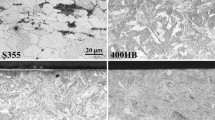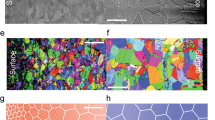Abstract
The mechanical response of materials under repeated impact loading is of primary importance to model different types of surface mechanical treatments, such as shot peening. A reverse identification method of stress–strain curves using repeated impact has been developed by Kermouche et al. [Kermouche et al., Mater. Sci. Eng., A 569, 71–77 (2013)] and later improved by Al Baida et al. [Al Baida et al., Mech. Mater. 86, 11–20 (2015)]. This study deals with the experimental validation of this method on three materials: a home-made pure iron, a commercially pure copper, and an industrial aluminum alloy. An approximate method derived from cone indentation theory to check the reverse method reliability. Balls of different sizes have been used to cover a wide enough range of strain. The results are also compared with macroscopic compression and traction tests. The effect of the strain rate on the stress–strain curve is discussed. The conclusion section highlights the rapidity and the ease of use of the reverse identification method.











Similar content being viewed by others
References
V.O. Abramov, O.V. Abramov, F. Sommer, O.M. Gradov, and O.M. Smirnov: Surface hardening of metals by ultrasonically accelerated small metal balls. Ultrasonics 36, 1013–1019 (1998).
H.Y. Miao, D. Demers, S. Larose, C. Perron, and M. Lévesque: Experimental study of shot peening and stress peen forming. J. Mater. Process. Technol. 210, 2089–2102 (2010).
K. Murugaratnam, S. Utili, and N. Petrinic: A combined DEM–FEM numerical method for shot peening parameter optimization. Adv. Eng. Softw. 79, 13–26 (2015).
G.I. Mylonas and G. Labeas: Numerical modelling of shot peening process and corresponding products: Residual stress, surface roughness and cold work prediction. Surf. Coat. Technol. 205, 4480–4494 (2011).
S.P.F.C. Jaspers and J.H. Dautzenberg: Material behaviour in conditions similar to metal cutting: Flow stress in the primary shear zone. J. Mater. Process. Technol. 122, 322–330 (2002).
M. Beghini, L. Bertini, and V. Fontanari: Evaluation of the stress–strain curve of metallic materials by spherical indentation. Int. J. Solids Struct. 43, 2441–2459 (2006).
J-M. Collin, G. Mauvoisin, O. Bartier, R. El Abdi, and P. Pilvin: Experimental evaluation of the stress–strain curve by continuous indentation using different indenter shapes. Mater. Sci. Eng., A 501, 140–145 (2009).
J-M. Collin, G. Mauvoisin, P. Pilvin, and R. El Abdi: Use of spherical indentation data changes to materials characterization based on a new multiple cyclic loading protocol. Mater. Sci. Eng., A 488, 608–622 (2008).
G. Kermouche, F. Grange, and C. Langlade: Local identification of the stress–strain curves of metals at a high strain rate using repeated micro-impact testing. Mater. Sci. Eng., A 569, 71–77 (2013).
S. Lamri, C. Langlade, and G. Kermouche: Damage phenomena of thin hard coatings submitted to repeated impacts: Influence of the substrate and film properties. Mater. Sci. Eng., A 560, 296–305 (2013).
M. Dao, K. Chollacoop, K.J. Van Vliet, T.A. Venkatesh, and S. Suresh: Computational modeling of the forward and reverse problems in instrumented sharp indentation. Acta Mater. 49, 3899–3918 (2001).
Y. Huang, X. Liu, Y. Zhou, Z. Ma, and C. Lu: Mathematical analysis on the uniqueness of reverse algorithm for measuring elastic-plastic properties by sharp indentation. J. Mater. Sci. Technol. 27, 577–584 (2011).
H. Al Baida, G. Kermouche, and C. Langlade: Development of an improved method for identifying material stress–strain curve using repeated micro-impact testing. Mech. Mater. 86, 11–20 (2015).
D. Systems: Abaqus Explicit (2011).
K.L. Johnson: Contact Mechanics (Cambridge University Press, Cambridge, UK, 1985).
R. Hill, B. Storakers, and A.B. Zdunek: A theoretical study of the Brinell hardness test. Proc. R. Soc. London, Ser. A 423, 301–330 (1989).
D. Tabor: The Hardness of Metals (Oxford University Press, Oxford, UK, 2000).
G. Kermouche, J-L. Loubet, and J-M. Bergheau: An approximate solution to the problem of cone or wedge indentation of elastoplastic solids. C. R. Méc. 333, 389–395 (2005).
C-H. Mok: The dependence of yield stress on strain rate as determined from ball-indentation tests. Exp. Mech. 6, 87–92 (1966).
G.R. Johnson and W.H. Cook: Fracture characteristics of three metals subjected to various strains, strain rates, temperatures and pressures. Eng. Fract. Mech. 21, 31–48 (1985).
M.A. Meyers: Dynamic Behavior of Materials (John Wiley & Sons, Hoboken, NJ, 1994).
C. Peng, Y. Zhong, Y. Lu, S. Narayanan, T. Zhu, and J. Lou: Strain rate dependent mechanical properties in single crystal nickel nanowires. Appl. Phys. Lett. 102, 083102 (2013).
V. Lacaille, G. Kermouche, D-Y.T. Spinel, E. Feulvarch, C. Morel, and J-M. Bergheau: Modeling nitriding enhancement resulting from the NanoPeening treatment of a pure iron. IOP Conf. Ser. Mater. Sci. Eng. 63, 012124 (2014).
D. Ostwaldt, J.R. Klepaczko, and P. Klimanek: Compression tests of polycrystalline α-iron up to high strains over a large range of strain rates. J. Phys. IV 07, 385–390 (1997).
H. Al Baida, C. Langlade, G. Kermouche, and R. Ambriz: Identification du comportement mécanique des matériaux à l’aide d’essais de micro-impact répétés. Matér. Tech. 102, 604 (2014).
R.R. Ambriz, C. Froustey, and G. Mesmacque: Determination of the tensile behavior at middle strain rate of AA6061-T6 aluminum alloy welds. Int. J. Impact Eng. 60, 107–119 (2013).
ACKNOWLEDGMENT
The authors gratefully acknowledge financial support from UTBM and the international relations that allocated funds for Mr. RR Ambriz as a visiting professor. They also wish to thank Mr. D. Schlegel and Mr. Th. Couturier for their help in the design and implementation of various indenter-holders and Mr. D. Tumbajoy for his help in the sample preparation and compression tests on pure iron and pure copper.
Author information
Authors and Affiliations
Corresponding author
Rights and permissions
About this article
Cite this article
Al Baida, H., Langlade, C., Kermouche, G. et al. Identifying the stress–strain curve of materials by microimpact testing. Application on pure copper, pure iron, and aluminum alloy 6061-T651. Journal of Materials Research 30, 2222–2230 (2015). https://doi.org/10.1557/jmr.2015.186
Received:
Accepted:
Published:
Issue Date:
DOI: https://doi.org/10.1557/jmr.2015.186




